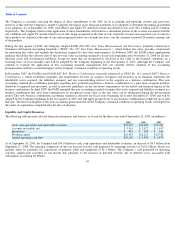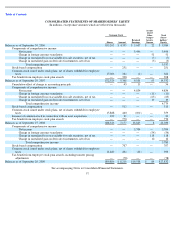Apple 2009 Annual Report Download - page 52
Download and view the complete annual report
Please find page 52 of the 2009 Apple annual report below. You can navigate through the pages in the report by either clicking on the pages listed below, or by using the keyword search tool below to find specific information within the annual report.
Table of Contents
The Company is currently assessing the impact of these amendments to the ASC on its accounting and reporting systems and processes;
however, at this time the Company is unable to quantify the impact on its financial statements of its adoption or determine the timing and method
of its adoption. As of September 26, 2009, total iPhone and Apple TV deferred revenue and deferred costs were $12.1 billion and $5.2 billion,
respectively. The Company believes that application of these amendments will result in a substantial portion of the revenue associated with the
sale of iPhone and Apple TV and all related cost of sales being recognized at the time of sale. Currently revenue and associated cost of sales for
these products are deferred at the time of sale and recognized ratably on a straight-line basis over the currently estimated 24-
month economic life
of the products.
During the first quarter of 2009, the Company adopted FASB ASC 820, Fair Value Measurements and Disclosures
(formerly referenced as
Statement of Financial Accounting Standards (“SFAS”) No. 157, Fair Value Measurements ) ,
which defines fair value, provides a framework
for measuring fair value, and expands the disclosures required for fair value measurements. In February 2008, the FASB issued supplemental
guidance that delays the effective date of this new fair value accounting standard to fiscal years beginning after November 15, 2008 for all non-
financial assets and non-
financial liabilities, except for items that are recognized or disclosed at fair value in the financial statements on a
recurring basis (at least annually) and will be adopted by the Company beginning in the first quarter of 2010. Although the Company will
continue to evaluate the application of this accounting standard, management does not currently believe adoption of this accounting
pronouncement will have a material impact on the Company’s financial condition or operating results.
In December 2007, the FASB issued FASB ASC 805, Business Combinations (formerly referenced as SFAS No. 141 (revised 2007),
Business
Combinations
), which establishes principles and requirements for how an acquirer recognizes and measures in its financial statements the
identifiable assets acquired, the liabilities assumed, and any noncontrolling interest in the acquiree in a business combination. This new
accounting standard also establishes principles regarding how goodwill acquired in a business combination or a gain from a bargain purchase
should be recognized and measured, as well as provides guidelines on the disclosure requirements on the nature and financial impact of the
business combination. In April 2009, the FASB amended this new accounting standard to require that assets acquired and liabilities assumed in a
business combination that arise from contingencies be recognized at fair value, if the fair value can be determined during the measurement
period. This new business combination accounting standard is effective for fiscal years beginning on or after December 15, 2008 and will be
adopted by the Company beginning in the first quarter of 2010 and will apply prospectively to any business combinations completed on or after
that date. The effect of adoption of this new accounting pronouncement on the Company’
s financial condition or operating results will depend on
the nature of acquisitions completed after the date of adoption.
Liquidity and Capital Resources
The following table presents selected financial information and statistics as of and for the three years ended September 26, 2009 (in millions):
As of September 26, 2009, the Company had $34.0 billion in cash, cash equivalents and marketable securities, an increase of $9.5 billion from
September 27, 2008. The principal component of this net increase was the cash generated by operating activities of $10.2 billion, which was
partially offset by payments for acquisitions of property, plant and equipment of $1.1 billion. The Company’
s cash generated by operating
activities significantly exceeded its net income due primarily to the increase in deferred revenue, net of deferred costs, associated with
subscription accounting for iPhone.
49
2009
2008
2007
Cash, cash equivalents and marketable securities
$
33,992
$
24,490
$
15,386
Accounts receivable, net
$
3,361
$
2,422
$
1,637
Inventories
$
455
$
509
$
346
Working capital
$
16,983
$
18,219
$
10,728
Annual operating cash flow
$
10,159
$
9,596
$
5,470
























